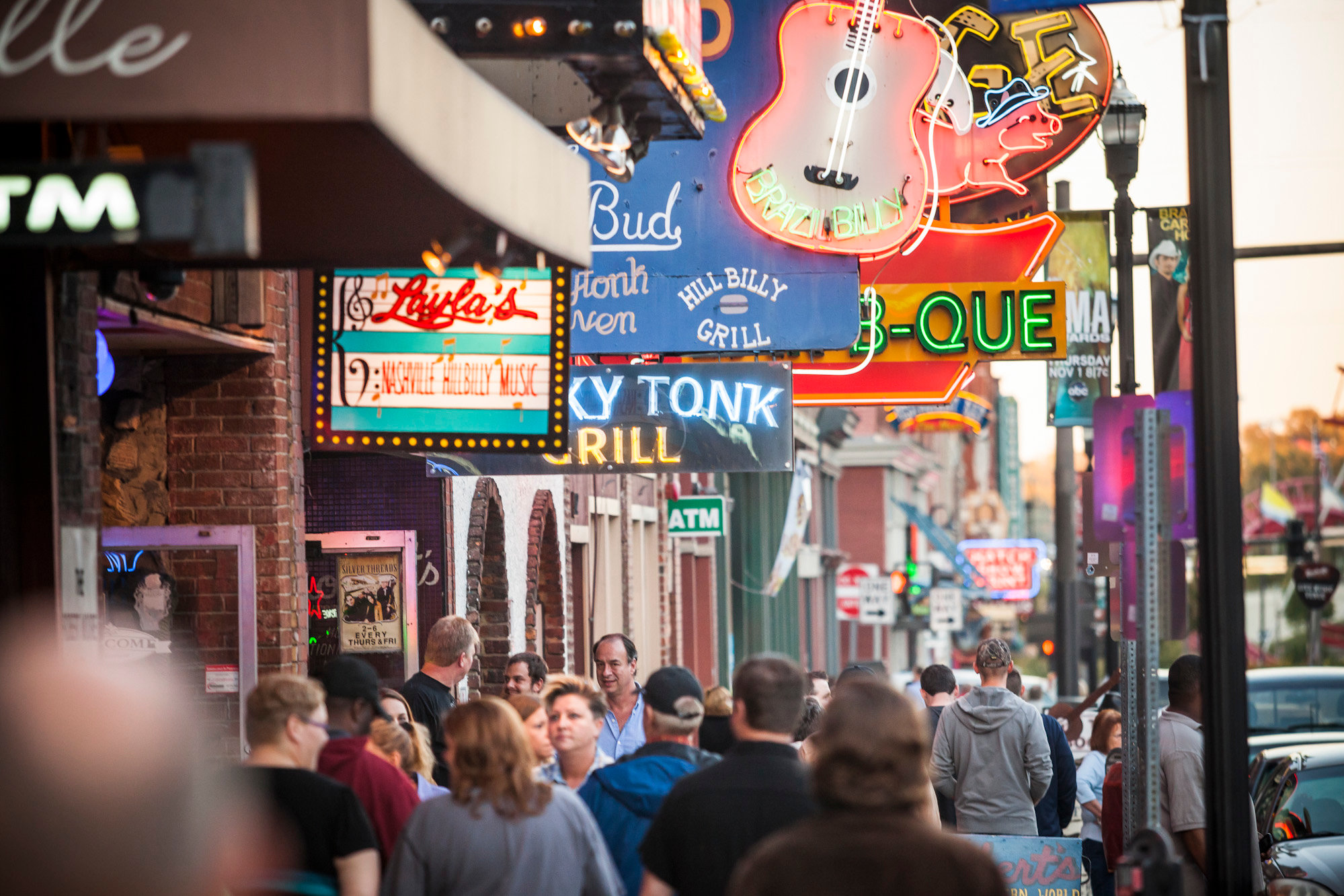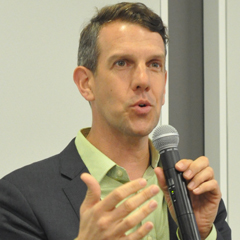While Barr’s mobility portfolio is principally focused on Massachusetts, we also pursue targeted national opportunities to support partners, like Transportation for America (T4A), to bring intellectual or financial resources to Massachusetts, and/or to provide platforms to share the effective work of partners in our local region. We recently invited James Corless, Transportation for America director, to share what lessons mobility efforts in Nashville, Tennessee, might have for the Boston region.
Many know Nashville for its country music, or even the eponymous reality TV show. But Nashville is also booming economically, attracting big companies as well as small start-ups, and is welcoming the world to its doorstep as a refugee resettlement center.
In the midst of all this change, Nashville is bringing its creativity and entrepreneurial spirit to new initiatives that include civic engagement, creative placemaking, and developing a bold new vision for a regional mass transit system.
These efforts certainly haven’t come easily. Nashville has been growing by leaps and bounds for more than a decade and has known for some time that it was following an exponential growth curve. Even before the turn of the most recent century, demographic projections had the Nashville region’s population doubling from 1 million to 2 million by 2040. Business and civic leaders recognized that they had to get ahead of this curve, to make sure they engaged in smart planning that could both help manage their growth and build the infrastructure to keep up with it.
Early leadership on public transportation came from the Nashville Area Metropolitan Planning Organization, an advocacy group known as the Transit Alliance, and the Nashville Chamber of Commerce. Nashville’s mayor at the time, Karl Dean, threw his political support behind a signature bus rapid transit project dubbed the “Amp.” On paper, the project was a transit planner’s dream. It would serve as a west-east connector, linking Vanderbilt University to downtown and the new Convention Center, by following a route across the Cumberland River to the Tennessee Titans Stadium and into east Nashville.
The project seemed to be sailing along, even winning the commitment of a federal “Small Starts” transit expansion grant. But the announcement of federal funding caught the attention of skeptical state legislators and a number of business owners along the transit corridor who were worried about the loss of parking and the elimination of left turn lanes. Seemingly overnight the project was thrown into jeopardy, when a state legislator introduced a bill to deny state funding to bus rapid transit projects. With controversy continuing to swirl around the project, city leaders were hopeful that a public outpouring of support could overwhelm the opposition. But what they found were neighborhoods—particularly communities of color in north and south Nashville that weren’t served by the Amp—had never understood that the transit project was part of a larger regional transit vision. They asked the age-old question, “What’s in it for us?” and didn’t see a compelling answer.
Without a strong grassroots presence that he could count on, Mayor Dean withdrew his support for the project—effectively shelving the Amp and forcing planners back to the drawing board.It was a serious setback.
But Nashville didn’t give up. Instead, the City and key partners launched several new initiatives to more deeply engage the public and to cultivate broader support for public transportation.Nashville’s transit agency kicked off a new strategic planning effort, asking riders and other residents to weigh in on what improvements to transit service they wanted to see. The Nashville Chamber of Commerce launched a new “Moving Forward” initiative to organize stronger and deeper support from the business community for robust public transit investments. And in South Nashville, home to booming populations of Latinos and recent immigrants, a social service agency called Conexión Américas hired a new community organizer to engage residents in a bottom-up planning process to help reimagine the busy Nolensville Pike that cuts through the heart of their community.
As opposed to the grandiose vision of the “Amp,” Conexión Américas started small and from the ground up. In August 2014, a new daycare center was about to open as part of Conexión’s “Casa Azafrán”—the site that serves as the group’s headquarters and a community center on Nolensville Pike, just a few miles south of downtown. Conexión Américas’ executive director, Renata Soto, saw a major missing piece of their plan. Because an influx of families would need to drop off their kids at the daycare, employees based at Casa Azafrán would need to park on the other side of Nolensville Pike across from the community center. But there was no crosswalk to get them from one side of the street to the other. Conexión staff worked diligently with Nashville’s public works department, the Nashville MPO, the Tennessee Department Transportation, and T4A to advocate for a safe and visible crosswalk. In just a few short months, by the opening day of the daycare center, Conexión had won not only a crosswalk, but the first bilingual crosswalk in the state of Tennessee, with signs and audible signals in both English and Spanish.
With a small but remarkably visible victory under its belt, Conexión then set its sights on engaging the community in a broader vision for transforming Nolensville Pike. With the support of T4A, a grant from The Kresge Foundation, and a partnership with Nashville’s Civic Design Center, Conexión Américas’ community organizer started an intensive outreach campaign to the small businesses and residents along an important section of Nolensville Pike to ask them what they envisioned for the future of the corridor. The meetings were dubbed “Creative Labs,” and it turned out people had a lot to say. Several themes emerged, including: safer streets; wide sidewalks; bicycle paths and more green space; faster and more frequent bus service; art and murals that tell the story of the community; and a new school designed specifically for a new wave of immigrant students.
Meeting people on their schedules, in their businesses and community spaces, proved time consuming, but incredibly fruitful. Residents starting offering ideas and insights into the bus service for the corridor, engagement that eventually helped shape a new rapid transit schedule that was unveiled in February 2016. Many of the immigrant-run small businesses, in an area the city has dubbed its “International District,” wanted help advertising their services and restaurants to a broader population beyond the corridor. Conexión also employed local artists to be part of this civic engagement process, using creative and visual techniques to engage residents at larger community meetings to discuss the future of the Pike. Those artists are now helping develop a new map of the corridor that shows everyone—residents and newcomers alike—where key businesses are located and how they can get there with the new rapid bus service.
Most importantly, the residents of south Nashville are now more deeply engaged in charting the future of their community than ever before. This type of grassroots support is going to be critical in other areas of Nashville, as the City now turns to the task of building its next generation of bus rapid transit routes all across the region. Like many regions of the country, transportation funding is limited compared to current needs and future opportunities; and new funding will likely depend on a new voter-approved transportation tax—something that will most certainly require both business leadership and local community support to pass.
While it may seem like a long way from Massachusetts to Middle Tennessee, let me suggest four critical takeaways that organizations and leaders in the Bay State can and should take to heart: Tweet This
Lots of public meetings don’t always translate into deep public support. In Nashville’s case, despite significant early outreach by public agencies, those initial efforts failed to generate deep or vocal enough public and grassroots support for the project. As a result, when opposition to the Amp bus rapid transit project surfaced, opponents quickly gained the upper hand.
The arts have a real potential to spark more creative and genuine civic engagement. As a former transportation planner, I know all too well how difficult it can be for transportation agencies to effectively engage the public and win their buy-in for new ideas, projects, and funding. But adding the arts, artists, and creativity into the mix can open new doors into the community. For example, Conexión Américas is undertaking an oral history project in which immigrant youth are interviewing long-time Nashville residents in order to spark a dialogue. Such creative engagement efforts can be a powerful. They can also strengthen cross-generational relationships and understanding that can lead to further conversations about a community’s future and the transportation network that will serve its people best.
When it comes to mass transit, beware of the single, signature project. Despite a regional plan and long-term vision for a regional transit system across the Nashville region, neighborhoods around Nashville saw only resources and attention flowing to one rapid transit corridor (the Amp), without a sense that it would benefit them.
Small victories mean a lot and often fuel longer lasting movements. For Conexión Américas, winning the new bilingual crosswalk in a matter of months was critical for the community in south Nashville to get a taste of success. This, in turn, has led to its continued involvement in even more ambitious and far-reaching plans to re-envision and improve the Nolensville Pike corridor.
Nashville has long been a region of creative thinkers and doers. It is now building on that history and tapping into the energy of its residents, from long-time Nashvillians to its newest immigrants, to help create safer streets, vibrant neighborhoods, a 21st-century public transit system, and a prosperous economy that works for everyone.




